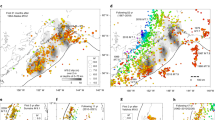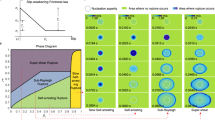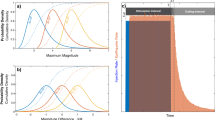Abstract
Resolving whether static1,2,3 or dynamic4,5,6,7,8 stress triggers most aftershocks and subsequent mainshocks is essential to understand earthquake interaction and to forecast seismic hazard9. Felzer and Brodsky10 examined the distance distribution of earthquakes occurring in the first five minutes after 2 ≤ M < 3 and 3 ≤ M < 4 mainshocks and found that their magnitude M ≥ 2 aftershocks showed a uniform power-law decay with slope −1.35 out to 50 km from the mainshocks. From this they argued that the distance decay could be explained only by dynamic triggering. Here we propose an alternative explanation for the decay, and subject their hypothesis to a series of tests, none of which it passes. At distances more than 300 m from the 2 ≤ M < 3 mainshocks, the seismicity decay 5 min before the mainshocks is indistinguishable from the decay five minutes afterwards, indicating that the mainshocks have no effect at distances outside their static triggering range. Omori temporal decay, the fundamental signature of aftershocks, is absent at distances exceeding 10 km from the mainshocks. Finally, the distance decay is found among aftershocks that occur before the arrival of the seismic wave front from the mainshock, which violates causality. We argue that Felzer and Brodsky10 implicitly assume that the first of two independent aftershocks along a fault rupture triggers the second, and that the first of two shocks in a creep- or intrusion-driven swarm triggers the second, when this need not be the case.
This is a preview of subscription content, access via your institution
Access options
Subscribe to this journal
Receive 51 print issues and online access
$199.00 per year
only $3.90 per issue
Buy this article
- Purchase on Springer Link
- Instant access to full article PDF
Prices may be subject to local taxes which are calculated during checkout





Similar content being viewed by others
References
Stein, R. S. The role of stress transfer in earthquake occurrence. Nature 402, 605–609 (1999)
Toda, S., Stein, R. S., Richards-Dinger, K. & Bozkurt, S. Forecasting the evolution of seismicity in southern California: animations built on earthquake stress transfer. J. Geophys. Res. 110 B05S16 10.1029/2004JB003415 (2005)
Parsons, T. Global observation of Omori-law decay in the rate of triggered earthquakes: large aftershocks outside the classical aftershock zone. J. Geophys. Res. 107 10.1029/2001JB000646 (2002)
Hill, D. P. et al. Seismicity remotely triggered by the magnitude 7.3 Landers, California, earthquake. Science 260, 1617–1623 (1993)
Kilb, D. A strong correlation between induced peak dynamic coulomb stress change from the 1992 M7.3 Landers, California, earthquake and the hypocenter of the 1999 M7.1 Hector Mine, California earthquake. J. Geophys. Res. 108, 10.1029/2001JB000678 (2003)
Brodsky, E. E. & Prejean, S. G. New constraints on mechanisms of remotely triggered seismicity at long valley caldera. J. Geophys. Res. 110 B04302 04310.01029/02004JB003211 (2005)
Gomberg, J. & Johnson, P. Dynamic triggering of earthquakes. Nature 437, 830 (2005)
Hill, D. P. & Prejean, S. G. in Treatise on Geophsyics (ed. Kanamori, H.) Vol. 4, 257–291 (Elsevier, 2007)
Freed, A. M. Earthquake triggering by static, dynamic, and postseismic stress transfer. Annu. Rev. Earth Planet. Sci. 33, 335–367 (2005)
Felzer, K. R. & Brodsky, E. E. Decay of aftershock density with distance indicates triggering by dynamic stress. Nature 441, 735–738 (2006)
Hardebeck, J. L., Nazareth, J. J. & Hauksson, E. The static stress change triggering model: constraints from two southern California aftershocks sequences. J. Geophys. Res. 103, 24427–24437 (1998)
Ma, K.-F., Chan, C.-H. & Stein, R. S. Response of seismicity to coulomb stress triggers and shadows of the 1999 Mw = 7.6 Chi-Chi, Taiwan, earthquake. J. Geophys. Res. 110 10.1029/2004JB003389 (2005)
Helmstetter, A., Kagan, Y. Y. & Jackson, D. D. Importance of small earthquakes for stress transfers and earthquake triggering. J. Geophys. Res. 110 B05S08 10.1029/2004JB003286 (2005)
Cochran, E. S., Vidale, J. E. & Tanaka, S. Earth tides can trigger shallow thrust fault earthquakes. Science 306, 1164–1166 (2004)
Brodsky, E., Karakostas, V. & Kanamori, H. A new observation of dynamically triggered regional seismicity: Earthquakes in Greece following the August, 1999 Izmit, Turkey earthquake. Geophys. Res. Lett. 27, 2741–2744 (2000)
Velasco, A. A., Hernandez, S., Parsons, T. & Pankow, K. Global ubiquity of dynamic earthquake triggering. Nature Geosci. 1 375–379 10.1038/ngeo204 (2008)
Miyazawa, M. & Brodsky, E. E. Deep low-frequency tremor that correlates with passing surface waves. J. Geophys. Res. 113 B01307 01310.01029/02006JB004890 (2008)
Jennings, P. C. & Kanamori, H. Effect of distance on local magnitudes found from strong-motion records. Bull. Seismol. Soc. Am. 73, 265–280 (1983)
Wells, D. L. & Coppersmith, K. J. New empirical relationships among magnitude, rupture length, rupture width, rupture area, and surface displacement. Bull. Seismol. Soc. Am. 84, 974–1002 (1994)
Felzer, K. R., Abercrombie, R. E. & Ekström, G. Secondary aftershocks and their importance for aftershock forecasting. Bull. Seismol. Soc. Am. 93, 1433–1448 (2003)
Abercrombie, R. E. Earthquake source scaling relationships from -1 to 5 ml using seismograms recorded at 2.5-km depth. J. Geophys. Res. 100, 24015–24036 (1995)
Marsan, D. & Lengliné, O. Extending earthquakes’ reach through cascading. Science 319, 1076–1079 (2008)
Hill, D. P., Johnston, M. J. S., Langbein, J. O. & Bilham, R. Response of Long Valley caldera to the Mw = 7.3 Landers, California, earthquake. J. Geophys. Res. 100, 12985–13005 (1995)
Toda, S., Stein, R. S. & Sagiya, T. Evidence from the A.D. 2000 Izu Islands swarm that seismicity is governed by stressing rate. Nature 419, 58–61 (2002)
Vidale, J. E. & Shearer, P. M. A survey of 71 earthquake bursts across southern California: exploring the role of pore fluid pressure fluctuations and aseismic slip as drivers. J. Geophys. Res. 111 B05312 05310.01029/02005JB004034 (2006)
Lohman, R. B. & McGuire, J. J. Earthquake swarms driven by aseismic creep in the Salton trough, California. J. Geophys. Res. 112 B04405 04410.01029/02006JB004596 (2007)
Woessner, J. & Wiemer, S. Assessing the quality of earthquake catalogues: estimating the magnitude of completeness and its uncertainty. Bull. Seismol. Soc. Am. 95, 684–698 (2005)
Wiemer, S. & Wyss, M. Minimum magnitude of completeness in earthquake catalogs: examples from Alaska, the western United States, and Japan. Bull. Seismol. Soc. Am. 90, 859–869 (2000)
Helmstetter, A. & Sornette, D. Subcritical and supercritical regimes in epidemic models of earthquake aftershocks. J. Geophys. Res. 107 2237 10.1029/2001JB001580 (2002)
Felzer, K., Abercrombie, R. & Ekström, G. Secondary aftershocks and their importance for aftershock forecasting. Bull. Seismol. Soc. Am. 93, 1433–1448 (2003)
Kendall, M. & Stuart, A. The Advanced Theory of Statistics Vol. 1 Distribution Theory Ch. 1 (Hafner, 1969)
Peng, Z. & Zhao, P. Migration of early aftershocks following the 2004 parkfield earthquake. Nature Geosci. 2 10.1038/ngeo1697 (2009)
Acknowledgements
We thank K. Felzer, E. Brodsky, D. Jackson, S. Steacy, J. Hardebeck, R. Harris, and I. Main for comprehensive reviews; and Z. Peng, J. Vidale and Y. Okada for comments.
Author information
Authors and Affiliations
Contributions
The authors contributed equally to the manuscript.
Corresponding author
Ethics declarations
Competing interests
The authors declare no competing financial interests.
Supplementary information
Supplementary Information
This file contains Supplementary Table 1 and Supplementary Figures 1-8 with legends. (PDF 5065 kb)
Rights and permissions
About this article
Cite this article
Richards-Dinger, K., Stein, R. & Toda, S. Decay of aftershock density with distance does not indicate triggering by dynamic stress. Nature 467, 583–586 (2010). https://doi.org/10.1038/nature09402
Received:
Accepted:
Published:
Issue Date:
DOI: https://doi.org/10.1038/nature09402
This article is cited by
-
Spatio-temporal clustering of successive earthquakes as inferred from analyses of global CMT and NIED F-net catalogs
Earth, Planets and Space (2022)
-
Accrual of widespread rock damage from the 2019 Ridgecrest earthquakes
Nature Geoscience (2022)
-
Modeling and Prediction of Aftershock Activity
Surveys in Geophysics (2022)
-
Earthquake triggering model based on normal-stress-dependent Nagata law: application to the 2016 Mie offshore earthquake
Earth, Planets and Space (2020)
-
One neuron versus deep learning in aftershock prediction
Nature (2019)
Comments
By submitting a comment you agree to abide by our Terms and Community Guidelines. If you find something abusive or that does not comply with our terms or guidelines please flag it as inappropriate.



